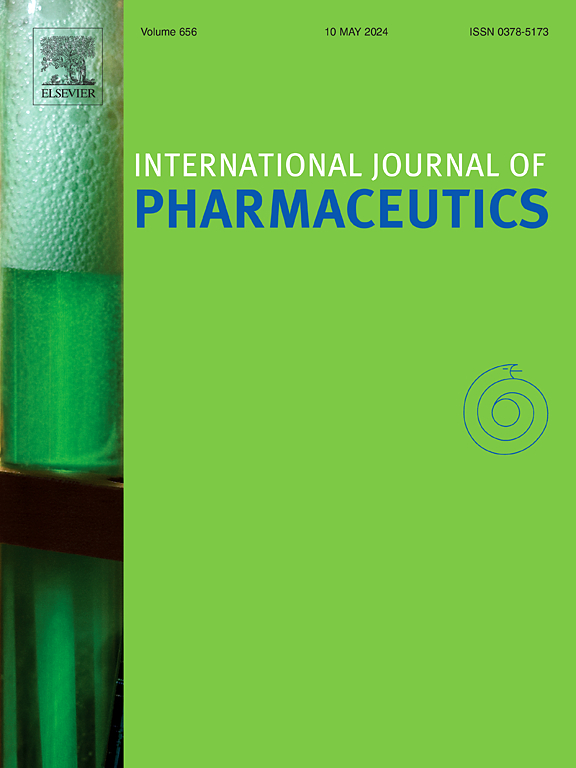Core-shell aerogel design for enhanced oral insulin delivery
IF 5.3
2区 医学
Q1 PHARMACOLOGY & PHARMACY
引用次数: 0
Abstract
Current protein-based therapies often rely on intravenous and subcutaneous injections leading to patient discomfort due to the need for frequent administration. Oral administration route presents a more patient-friendly alternative, but overcoming the challenge of low drug bioavailability remains paramount. This limitation is primarily attributed to protein degradation in the harsh gastric environment, enzymatic breakdown, and poor intestinal permeability. With their unique properties, such as high porosity and surface area, and easy scalability, aerogels offer a promising platform for oral delivery of therapeutic proteins. This study focused on the development and characterization of both conventional and core–shell aerogels derived from natural polysaccharides for the oral delivery of insulin, utilizing Humulin R® U-100 as the insulin source for the first time. Aerogels were produced via supercritical carbon dioxide (sc-CO2) drying of alginate gel beads. Scanning Electron Microscopy (SEM) images confirmed that the core–shell aerogels had higher uniformity in size and a more well-defined porous structure in comparison to conventional aerogels. Structural differences of two alginate sources were evaluated by Fourier Transform Infrared (FTIR) spectroscopy. A notable difference in encapsulation efficiencies was observed between conventional (12 %) and core–shell (53 %) aerogels, highlighting the superior carrier characteristics of the latter ones. In vitro insulin release profiles from the core–shell aerogels demonstrated their potential suitability for delivering regular/short-acting insulin therapeutics since only 30 % of insulin was released in Simulated Gastric Fluid (SGF) after 120 min, whereas 60 % of insulin was released in Simulated Intestinal Fluid (SIF) within the first hour followed by a sustained release stage.

增强口服胰岛素输送的核-壳气凝胶设计。
目前基于蛋白质的治疗通常依赖于静脉注射和皮下注射,由于需要频繁给药,导致患者不适。口服给药途径是一种对患者更友好的选择,但克服低药物生物利用度的挑战仍然是最重要的。这种限制主要是由于在恶劣的胃环境中蛋白质降解、酶分解和肠通透性差。由于其独特的特性,如高孔隙率和表面积,以及易于扩展,气凝胶为口服递送治疗性蛋白质提供了一个很有前途的平台。本研究首次利用Humulin R®U-100作为胰岛素源,开发了用于口服胰岛素的常规气凝胶和天然多糖提取的核壳气凝胶。采用超临界二氧化碳(sc-CO2)干燥海藻酸盐凝胶球制备气凝胶。扫描电镜(SEM)图像证实,与传统气凝胶相比,核壳气凝胶具有更高的尺寸均匀性和更明确的多孔结构。利用傅里叶变换红外光谱(FTIR)分析了两种海藻酸盐源的结构差异。常规气凝胶(12 %)和核壳气凝胶(53 %)的包封效率有显著差异,表明后者具有更好的载体特性。核-壳气凝胶的体外胰岛素释放分析表明,由于在120 min后,模拟胃液(SGF)中只有30% %的胰岛素释放,而模拟肠液(SIF)中有60% %的胰岛素在第一个小时内释放,随后是一个持续释放阶段,因此它们具有提供常规/短效胰岛素治疗的潜在适应性。
本文章由计算机程序翻译,如有差异,请以英文原文为准。
求助全文
约1分钟内获得全文
求助全文
来源期刊
CiteScore
10.70
自引率
8.60%
发文量
951
审稿时长
72 days
期刊介绍:
The International Journal of Pharmaceutics is the third most cited journal in the "Pharmacy & Pharmacology" category out of 366 journals, being the true home for pharmaceutical scientists concerned with the physical, chemical and biological properties of devices and delivery systems for drugs, vaccines and biologicals, including their design, manufacture and evaluation. This includes evaluation of the properties of drugs, excipients such as surfactants and polymers and novel materials. The journal has special sections on pharmaceutical nanotechnology and personalized medicines, and publishes research papers, reviews, commentaries and letters to the editor as well as special issues.

 求助内容:
求助内容: 应助结果提醒方式:
应助结果提醒方式:


